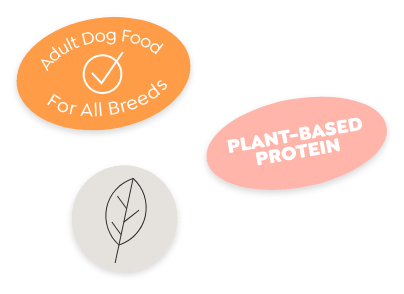HOW WE GRADE
While every dog is a
10 out of 10, judging their food requires a more critical lens
We evaluate foods using third-party evaluation criteria - like recommendations from the World Small Animal Veterinary Association (WSAVA) and sustainability metrics from the University of Michigan - to ensure our scoring method is evidence-based and reflects expert opinion.

NUTRITION
TOP INGREDIENTS
What are the main ingredients? Where do they come from and how processed are they?
Scoring
Of the top 5 ingredients on label:
Whole, unprocessed foods (+1 pt)
Processed plant-based proteins or derivatives (+0.5 pt)
Processed animal by-products (+0 pt)
Rationale
There are different opinions about optimal nutrient ratios, but most nutritionists agree that “whole” foods - i.e. minimally processed and/or fresh - are preferable.
Processing - whether rendering and drying animal flesh into meat meal, separating grains into different components, or concentrating proteins - strips some nutrients and also introduces additional steps in the supply chain for issues to emerge.
Processed animal by-product is particularly problematic because it likely includes meat from sick or dead animals that are deemed unfit for human consumption due to safety concerns.
+
EXPERT-FORMULATED
Is the formula created by experts?
Scoring
Named board-certified veterinary nutritionist or animal nutrition Ph.D (+1 pt)
Named credentialed veterinary nutritionist (+0.5 pt)
Does not name the formulator(s) (+0 pt)
Rationale
WSAVA recommends companies that employ a full-time nutritionist who holds either a PhD in animal nutrition or board certification from the American College of Veterinary Nutrition.
Full-time employment is not necessary or feasible for many companies with a more limited product catalog, so we award partial points to companies that name qualified nutritionist formulators regardless of employment status.
RESEARCH
Has the company conducted research about the nutritional quality and health outcomes? Does the company substantiate health-related marketing claims?
Scoring
Shares peer-reviewed studies (+1 pt)
Shares non-reviewed studies (+0.5 points)
Makes unsubstantiated health claims (-1 pt)
Rationale
Publishing studies in peer-reviewed journals is the top scientific standard.
We award partial points to companies that share unpublished or unreviewed research given many companies cannot afford the additional costs of academic-quality research.
We deduct a point if brands make claims about the health outcomes or effects of their product and do not share any scientific support. Some pet food companies have been sued for unverifiable claims of health benefits and the pet food industry suffers from low credibility due to frequent misrepresentation of health benefits.
+
APPROACH
Is the nutritional approach in line with the consensus of veterinary nutritionists?
Scoring
Meets AAFCO standards (+1 pt)
In-line with common practice of veterinary nutrition (+1 pt)
Rationale
To be considered complete and balanced every pet food must either be formulated to meet AAFCO standards (i.e. nutritional analysis confirms nutrients meet the AAFCO benchmarks) or validated via a 6 month feeding trial with 6+ dogs. It is very rare that a food does meet either criterion, although many do not actually meet the nutritional standards when independently tested.
Beyond AAFCO standards, there are nutritional approaches with varying degrees of support among veterinary nutritionists. For example, you’ll find some credentialed veterinary nutritionists that do not recommend grain-free, raw, plant-based, or other dietary approaches.
+
LABELING
Does the brand provide additional nutritional information on par with human food labeling?
Scoring
Shares nutritional information about all essential nutrients (+1 pt)
Rationale
A single diet often accounts for 90%+ of a dog’s total calories, yet pet food companies rarely share meaningful nutritional information with pet owners.Current pet food regulations only require companies to share limited nutritional information.
The guaranteed minimum percentage of protein and maximum percentage of fat, fiber, and moisture.
Pet nutritional experts advocate for companies to share more nutritional information, including information that is legally required on human food labels. The gold standard is sharing a lab-verified analysis of all the nutrients that AAFCO considers essential to canine nutrition.
TESTING
Does the brand share metrics about the digestibility of the food?
Scoring
Shares digestibility testing methodology (+0.5 pt) and test results (+0.5 pt)
Rationale
Pet food has traditionally relied on cheap by-products as major nutrition sources, and those by-products are often less nutritious because they contain larger portions of indigestible substances (like bone ash) and/or have been exposed to multiple processing steps that degrade nutrients..
As a result, digestibility - or the ability for dogs to actually break down and absorb nutrients from the food - is a bigger concern than in human food. Many pet nutrition experts call for companies to share results of digestibility tests so that consumers and experts can make informed decisions about food quality.
+
SUPPLY CHAIN
Does the brand share information about its suppliers and/or manufacturer?
Scoring
Provides locations (+0.5pt) or names (+1 pt) of key suppliers
Specifies if it operates its own manufacturing facility or names a third-party manufacturer (+1 pt)
Rationale
Supplier transparency is critical not only for informing ingredient quality but also for improving supply chain sustainability.
“Feed grade” ingredients face less regulatory scrutiny than human-food-grade imports, and food safety laws differ significantly by country.
Weak environmental protection laws also make some ingredients particularly problematic if sourced from certain countries Many companies use third-party manufacturers (called co-packers or contract manufacturers) to produce their products. While these contract manufacturers are often experts and allow smaller brands to employ best-in-class safety and quality practices, it is important for customers to know who is responsible for handling their pet’s food.
+
PRODUCTION
HEAT EXPOSURE
How is the food made?
Scoring
Lightly-Cooked “Fresh” (+4 pt)
Canned & Dehydrated (Air, Freeze-Dried, etc.) (+3 pt)
Dry - Baked (+2 pt)
Dry - Extruded / Pressure-Cooked (+1 pt) Raw (+0 pt)
Rationale
Heat has an important role in nutrition and safety. Cooking food is critical to kill potentially toxic microorganisms.
It also makes many plant-based nutrients more digestible and accessible. However, applying a lot of heat can also degrade protein, particularly the amino acid lysine, as well as many vitamins.
Moderately-cooked “fresh” food is generally the most digestible and has the least protein degradation. Canned foods have more preservatives added and are generally of lower quality to enable a long shelf life.
For dry foods, dehydrated meats are nutritionally similar to moderately-cooked “fresh”, but the lack of heat is not optimal for plant-based ingredients that often need some heat. Baked foods have some nutritional advantages over extruded foods, which are cooked at a high pressure for a short time - such as a lower glycemic index and less fat oxidation.
Most veterinary nutritionists warn against commercial raw food due to the high levels of toxic microorganisms that can make dogs or family members sick and similar or worse digestibility than cooked fresh food.
+
LIVESTOCK WELFARE
What are the welfare standards for animal-derived ingredients?
Scoring
Animal-free / vegan (+3 pt)
Certified humane (+2 pt)
Enhanced welfare standards, organic, and/or named suppliers (+1 pt)
Rationale
The best way to prevent animal suffering is by entirely removing livestock from the supply chain. 99% of animal ingredients used in pet food come from “factory farms” - or concentrated animal feeding operations - which cause unnecessary suffering in the animals’ short lives .
Animal welfare certifications - such as Global Animal Partnership and Certified Humane - offer higher welfare standards and perform farm audits to ensure compliance.
Non-certified claims about pasture-raised, free-range, cage-free, grass-fed, and others bring some animal welfare benefits, although the impact can range dramatically.
Many enhanced welfare claims - such as “hormone-free” chicken - are misleading as they represent the legally-required basic animal protections (i.e. hormones are not allowed to be used on any chickens in the United States).
+
ANIMAL TESTING
Does the company use laboratory animals for testing?
Scoring
No laboratory animals (in-home volunteers and/or in vitro testing) (+1 pt)
Rationale
While its not feasible to completly avoid animal testing for pet food (animals will eat it eventually), there are best practices for avoiding harm to animals as part of pet food R&D while ensuring the product meets health and nutritonal standards.
Organizations that monitor animal testing and advocate for more humane approachs prohibit the use of laboratory animals - such as dog kennels owned and operated by academic centers or corporations - in R&D on pet food and pet food ingredients. They recommend that companies use in vitro (i.e. animal-free) laboratory tests and volunteer companion animals for taste-testing once the food has been cleared as safe.
+
RECALL HISTORY
What is the brand’s quality / safety record? Have they had any recalls or FDA cautions? Can the company communicate with customers in case of a product issue?
Scoring
USDA-inspected (food-grade) facility OR large manufacturer (>$500M sales) with no recall history (+3 pt)
Mid-Sized Manufacturer ($100-500M sales) with no recall history - (+2 pt)
Small Manufacturer (+1 pt)
Significant recall history(+0 pt)
Direct consumer relationship & batch tracking (+1 pt)
Rationale
Recalls are not a perfect proxy for safety, but are a quantifiable and public way to evaluate commitment to quality control.
Size is also an indicator of quality control practices, as brands producing large volumes of food without product recalls generally have more stringent quality control processes in place.
Certifications - such as USDA inspection required for facilities making “human grade” foods - can also be reasonably interpreted as higher quality control.
Companies that distribute their products directly to customers over the internet are better equipped to handle any safety issues as they can directly contact recipients of potentially impacted products.
+
SUSTAINABILITY
FRESH WATER & LAND USE
How much freshwater, land, and energy is required to produce the food?
Scoring
Primarily plant-, fungi-, or insect-based protein (+3 pt)
Primarily meat by-products (+2 pt)
Primarily poultry or pork (+1 pt)
Primarily beef, lamb, or fish (+0 pt)
Feed-grade (+1 pt)
Rationale
We used widely-accepted life cycle assessments that quantify the land use and freshwater withdrawals for different food sources.
Ruminants - i.e. cows and sheep (lambs) - generally require the most land and freshwater as they are the least efficient at converting feed into body mass so require more food, in the form of pasture land grass or grain feed. Farming fish is also extremely freshwater intensive.
Poultry and pigs are more efficient at converting food into mass, but are still more resource-intensive than consuming plants directly (with a few exceptions that are rarely used in pet food).
Pet foods that use true by-products - i.e. parts of animals that are considered inedible to humans - are more resource efficient as they are upcycling food that has limited other uses (generally feed for livestock or as fertilizer).
“Human grade” foods are most likely to be directly competitive with human food sources and drive the most incremental demand for additional agricultural outputs.
+
GREENHOUSE GAS EMISSIONS
How much does the food contribute to climate change?
Scoring
Primarily plant-, fungi-, or insect-based protein (+3 pt)
Primarily meat by-products (+2 pt)
Primarily poultry, pork, or fish (+1 pt)
Primarily beef or lamb (+0 pt)
Feed-grade ingredients (+1 pt)
Rationale
We used widely-accepted life cycle assessments that quantify the greenhouse gas emissions associated with different food sources. The largest greenhouse contributors are emissions related to land use changes ( such as deforestation to clear cropland), methane emissions (from livestock, fertilizer, and flooded soil), and carbon dioxide emissions from farm and boat equipment and synthetic fertilizer production. For animal ingredients, the emissions from the production of feed crops also plays a big role.
Ruminants - and especially cows - have far and away the highest carbon footprint due to the high methane production from gut fermentation of grass and grains.
Poultry and pig meat do not produce much methane but require crop feed that results in a 3x - 10x higher footprint than consuming most plants directly. Fish - both wild and farmed - emits similar GHG through boat fuel and farming equipment.
Pet foods that use true by-products - i.e. parts of animals that are considered inedible to humans - are allocated a lower share of the greenhouse emissions due to the limited alternative uses and lower economic value.
“Human grade” foods are most likely to be directly competitive with human food sources and drive the most incremental demand for additional agricultural outputs.
+
ORGANIC
Does the food support organic agriculture?
Scoring
Certified organic (+2 pt)
>50% organic ingredients (+1 pt)
<10% organic ingredients (+0 pt)
Rationale
Organic agriculture aims to increase sustainability, soil fertility, and biodiversity on farmland and limits the use of synthetic pesticides and fertilizers.
As a result, organic farms have higher biodiversity metrics, lower fertilizer-related methane emissions, healthier soil, and lower toxic pesticide exposure for farmworkers.
+
BIODIVERSITY
Does the food use ingredients that are grown in mono- or duo-cultures?
Scoring
Does not use crops prone to monocultures as ingredients or livestock feed (+2 pt)
Does not use crops prone to monocultures as ingredients but likely uses as livestock feed (+1 pt)
Uses crops prone to industrialized monocultures as ingredients (+0 pt)
Rationale
Monocultures - or the practice of growing very large fields of a single crop - also have negative environmental impact through reduced biodiversity, lower disease and pest tolerance, and soil nutrient depletion.
This practice is most common for the major commodity crops in the US - corn, soy, and wheat - which are most incentivized by agricultural subsidy programs and have the most economic benefits to scale. Over 50% of US farmland grows only corn and/or soy.
+
PACKAGING & DISTRIBUTION
How much waste does the food’s packaging and distribution create?
Scoring
Dry food w/ renewable packaging (+4 pt)
Dry food with conventional packaging (+3 pt)
Canned / shelf-stable wet food (+2 pt)
Refrigerated or frozen food sold through brick & mortar stores (+1 pt)
Refrigerated or frozen food sold primarily direct-to-consumer (+0 pt)
Rationale
Dry dog food requires less packaging per calorie than wet food, and the higher water content of wet food also requires more energy for transportation.
Shelf-stable dry food requires multiple layers of packaging to ensure it does not go stale, and the plastic or bio-plastic layers cannot be recycled or composted with current technology (at least for curbside trash pickup).
However, using renewable sources for the layers - such as paper and sugarcane - is more sustainable than entirely plastic-based bags.
Food that requires refrigeration consumes significantly more energy than shelf-stable wet and dry food. Buying refrigerated food at retail stores generally requires less waste than ordering online, as shipping food with ice packs and insulation dramatically increases packaging waste and transport energy.
+
EXPERT-FORMULATED
Does the company’s legal structure reward and encourage sustainability? What commitments has the company made to achieve their mission?
Scoring
Certified B Corp (+2 pt)
Shares a CSR or public benefit statement / mission (+1 pt)
Rationale
Certified B Corporations are a new kind of business that balances purpose and profit. They are legally required to consider the impact of their decisions on their workers, customers, suppliers, community, and the environment.
These businesses are evaluated and scored by an independent third-party (B Labs) and must provide radical transparency into their sustainability programs.
While this corporate structure is the gold standard for CSR, non-certified companies can start by drafting and sharing plans and commitments to benefit the community and environment.
COMMUNITY & EMPLOYEE INVESTMENT
Does the company invest in its community and employees? Does the company own its own manufacturing facilities and/or ingredient suppliers?
Scoring
Owns own manufacturing facilities (+0.5 pt)
Owns manufacturing facilities and offers enhanced employee benefits (living wage, opportunities for under-represented groups, etc). (+1 pt)
Rationale
Companies that own and operate their own manufacturing facilities have a larger impact in their community and more opportunity to create jobs with sustainable pay and benefits, such as a living wage and health care for all employees.
+
NON-PROFITS
Does the company support non-profit organizations aligned with its mission?
Scoring
Some non-profit partner campaigns (+0.5 pt)
Recurring support or long-term non-profit partnership (+1 pt)
Rationale
Non-profit partnerships enable companies to support their mission beyond normal company operations. Any type of corporate giving is beneficial, but long-term, structured partnerships - such as a buy-one-give-one model - make the most significant impact.














